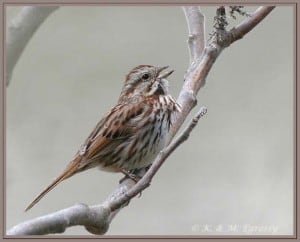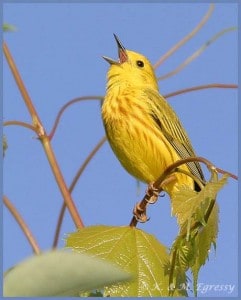Knowing the songs of common birds opens the door to greater enjoyment of the natural world
May’s explosion of leaves will soon draw a green veil upon our neighbourhoods and woodlands. As beautiful and welcome as the burst of foliage may be, it complicates seeing and appreciating the many bird species that make spring such a wonderful season. To be fully aware of all the avian diversity that surrounds us, we therefore need to depend on our ears as much as our eyes. Knowing the songs and calls also means you don’t have to spend a lot of time and energy tracking down the mystery songsters.
With practice, nearly all birds can be identified by their vocalizations, namely their songs and calls. The distinction between songs and calls can be complicated but, in general, songs are longer and more complex and are associated with courtship and mating. They are usually heard only in the spring and early summer. Calls tend to be short – sometimes only one or two notes – and serve as alarms or keeping members of a flock together. A good example is the Black-capped Chickadee. It makes its “chick-a-dee-dee” call all year round, but usually only whistles its “Hi-cutie” song in late winter and spring.
Describing songs
Learning and describing bird song involves some special vocabulary. For example, when talking about the quality or tone of the song, we often use words like clear, harsh, liquid, flute-like, trilled, or buzzy. A clear song is something you could whistle (e.g., American Robin, Northern Cardinal); a harsh song has scratchy notes (e.g., Common Grackle, House Finch); a flute-like song suggests a musical instrument (e.g., Wood Thrush, Hermit Thrush); a trilled song contains numerous notes in a row and too fast to count (e.g., Chipping Sparrow, Pine Warbler); while a buzzy song has a bee-like quality (e.g., Savannah Sparrow, many warblers).
Songs also differ in pitch. Most birds sing in a characteristic range, with smaller birds typically having higher voices than larger birds. The pitch might rise as the bird sings (e.g., Prairie Warbler), fall (e.g., Veery, Northern Waterthrush), remain steady (e.g., Chipping Sparrow, Dark-eyed Junco), or be variable (e.g., Song Sparrow).
Some birds characteristically repeat syllables or phrases. Brown Thrashers and Indigo Buntings typically repeat twice before changing to a new syllable. Often, bird songs can also be broken down into sections. A section begins whenever there is a dramatic change in pitch or speed. The Song Sparrow has many sections in its song, as does the European Starling. Birds also sing with different rhythms. House Wrens pour out their song in a hurry, while White-throated Sparrows opt for a leisurely pace. There is no doubt that some species sound similar. However, when you take into consideration the context of the song – habitat, time of year and the characteristics of the song itself – the choice usually comes down to only a handful of species.
Memory aids
Memorizing bird song as pure sound is difficult. For me at least, it is much easier to convert the songs to a mnemonic, which is simply any device that serves as a memory aid. Sometimes, it’s useful to find your own, personal comparison or memory aid for remembering a song.
The following is a list of mnemonics that birders have been using for years. I have grouped the birds by the habitat in which they are most typically found: MH (many habitats), U (urban), W (wetlands), FF (fields and farmland), F (forests)
American Robin (MH): CHEERILY-CHEERY-CHEERILY-CHEER… – a series of short, clear, musical whistles, rising and falling in pitch. Robins are especially vocal just before dawn.
American Goldfinch (MH): PO-TA-TO-CHIP! – this distinctive call is given on the up rise of the goldfinch’s roller-coaster flight.
Black-capped Chickadee (MH): HI-CUTY or SPRING-IS-HERE – a clear, two or three note whistle. The last note drops in pitch is often double-pulsed.
Blue Jay (MH): QUEEDLE-QUEEDLE – a pleasant, musical song, given in a quick burst. Listen also for “squeaky wheelbarrow” sounds and the jay’s harsh, descending “jaaaay” scream.
Cedar Waxwing (MH): SREEEE-SREEEE-SREEEE – an extremely high-pitched, hissy, weak, non-musical whistle. This is a common late summer sound in the Kawarthas.
Chipping Sparrow (MH): a mechanical, rapid trill consisting of dry chips, lasting several seconds, and almost sounding like a fast-running sewing machine.
Eastern Phoebe (MH): FEE-BEEE – a very emphatic, two-note song with a raspy or burred second note. It is repeated constantly. Phoebes are most commonly found around cottage and farm outbuildings.
House Wren (MH): a rapid, bubbling series of trills and rattles, both rising and descending. This bird can be a non-stop singer practically all day long.
Mourning Dove (MH): HOOO-AH-HOO-HOO-HOO – very slow and “mourning.” The song could be mistaken for that of an owl.
Song Sparrow (MH): MAIDS-MAIDS-MAIDS-PUT-ON-YOUR-TEA-KETTLE-ETTLE-ETTLE – a variable, complex series of notes that includes one long trill in the middle.
Chimney Swift (U): CHIT-CHIT-CHIT-CHIT – an ultra-rapid burst of notes given as the birds fly overhead, usually in Peterborough’s downtown core.
European Starling (U): WHEEEE-ERR – a long, down-slurred “wolf-whistle,” accompanied by an unmusical series of chips, squawks and squeaky notes. Starlings often sing from telephone wires.
House Finch (U): think of this bird as “the mad warbler” because of its loud, bubbly, quick-paced, warbled song. Harsh “churr” notes are often included. This bird often sings from the very top of spruce trees in the city.
House Sparrow (U): CHIDDIK-CHIDDIK… – a dry, monotonous series of identical chips.
Northern Cardinal (U): TWEER-TWEER-WHIT-WHIT-WHIT-WHIT or BIRDY-BIRDY-BIRDY-BIRDY – a loud, rich and persistent song, usually sung from a high perch.
Red-winged Blackbird (W): KON-KA-REEEEE – a harsh, gurgling song ending in a trill.
Common Yellowthroat (W): WITCHITY-WITCHITY-WITCHITY-WITCH – a song characterized by an up and down rolling rhythm.
Yellow Warbler (W): SWEET-SWEET-SWEET-I’M-SO-SWEET – clear, high, whistled notes that are rushed at the end.
Bobolink (FF): – a rolling, bubbling (boboling!) warble of very short notes that seem to almost trip over each other. It is given as the bird flies low over a hay field.
Eastern Meadowlark (FF): SPRING-OF-THE-YEAR – a slow, clear, slurred whistle that carries surprisingly far.
Killdeer (FF): KILL-DEEEEER or KEE-DEE – a high, strident song, often given in flight.
Ovenbird (F): t-CHER-t-CHER-t-CHER-t-CHER-t-CHER! – a loud, ringing, series of two-syllable “teacher” notes repeated quickly and accented on the second syllable.
Veery (F): VER-VEER-VEER-VEER-VEER- a smooth, calming series of fluty, ethereal notes that spiral downward.
Red-eyed Vireo (F): LOOK-UP, OVER-HERE, SEE-MEE, UP-HERE… – a series of simple, whistled, robin-like phrases, repeated over and over and sung from tree tops both in the city and county.
Resources
Thanks to a plethora of bird apps and websites, learning bird songs and calls is easier than ever. One of the most convenient ways is to use an app such as Merlin (free) or the Sibley eGuide to Birds. Both these apps provide a number of different songs and calls for each species. This is because there are often regional differences or “dialects” within the same species. Another wonderful resource is xeno-canto.org. This is a website at which volunteers share recordings of sounds of wild birds from across the world. You can download the songs to your phone or computer, as well. This is something many birders do when they travel and want to have the songs handy. Instructions for doing this can be found under “Frequently Asked Questions”. If you wish to watch a given bird as it sings, try searching on YouTube.
Some people find it useful to visualize bird songs using spectrograms (sonograms). They are a visual representation of a bird’s song. If you wish to try this technique, Google “Bird Song Hero”. This is a game in which you match the song to a choice of three spectrograms. Finally, I would also recommend allaboutbirds.org which is usually the first website that comes up when you search for a given bird on line. Click on the Sounds tab. If you go to the Topics tab and select “Bird ID Skills”, there is also an excellent resource called “How to Learn Bird Songs and Calls”.
Being able to recognize bird song is one of the most satisfying ways to enjoy the natural world. To the practiced ear, a chorus of bird song is like a symphony in which you recognize each of the individual instruments. Stepping out the back door or walking down a forest trail and hearing the expected birds singing in the expected locations provides a reassurance that the bird community is healthy, and the seasonal rhythms of the natural world are occurring as they should.
Climate Crisis News
In a U.N. report released this week, we learned that up to 1 million of the Earth’s plant and animal species are at risk of extinction — and many within decades. In the Kawarthas, this will mean saying goodbye to species such as Golden-winged Warbler, Least Bittern, Eastern Wolf and Spotted Turtle. The burgeoning growth of humanity is putting the world’s biodiversity at perilous risk with alarming implications for human survival. Climate change is a major driver of the extinction crisis and is on track to become the dominant pressure on many natural systems in coming decades. It is already exacerbating the effects of overfishing, pesticide use, pollution and both urban and agricultural expansion into the natural world. Sustained public pressure on politicians for enlightened climate action is absolutely necessary. The Ford government’s environmental policies are the antithesis of enlightened action. It’s heart-wrenching to think that the so many of the wild animals in the bedtime stories we read to our children and grandchildren will soon be gone.

